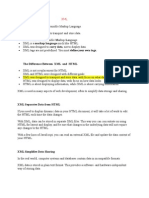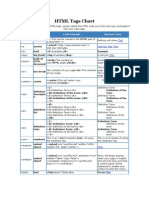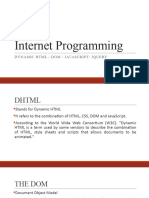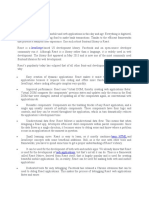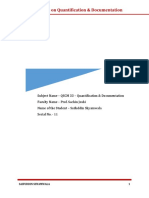0 ratings0% found this document useful (0 votes)
143 viewsCore Web Programming - Chapter 23: Document Object Model DOM
DOM Advantages:
Robust API for the DOM Tree
Relatively simple to modify the data structure and extract data
DOM Disadvantges
Stores the entire document in memory
As DOM was written for any language, method naming conventions don't follow standard Java programmng conventions
Uploaded by
J. Albert Bowden IICopyright
© © All Rights Reserved
We take content rights seriously. If you suspect this is your content, claim it here.
Available Formats
Download as PDF, TXT or read online on Scribd
0 ratings0% found this document useful (0 votes)
143 viewsCore Web Programming - Chapter 23: Document Object Model DOM
DOM Advantages:
Robust API for the DOM Tree
Relatively simple to modify the data structure and extract data
DOM Disadvantges
Stores the entire document in memory
As DOM was written for any language, method naming conventions don't follow standard Java programmng conventions
Uploaded by
J. Albert Bowden IICopyright
© © All Rights Reserved
We take content rights seriously. If you suspect this is your content, claim it here.
Available Formats
Download as PDF, TXT or read online on Scribd
You are on page 1/ 34
1
2001-2002 Marty Hall, Larry Brown http://www.corewebprogramming.com
core
programming
Document Object
Model
DOM
DOM 2
www.corewebprogramming.com
Agenda
Introduction to DOM
Java API for XML Parsing (JAXP)
Installation and setup
Steps for DOM parsing
Example
Representing an XML Document as a JTree
DOM or SAX?
DOM 3
www.corewebprogramming.com
Document Object Model (DOM)
DOM supports navigating and modifying
XML documents
Hierarchical tree representation of document
Tree follows standard API
Creating tree is vendor specific
DOM is a language-neutral specification
Bindings exists for Java, C++, CORBA, JavaScript
DOM Versions
DOM 1.0 (1998)
DOM 2.0 Core Specification (2000)
Official Website for DOM
http://www.w3c.org/DOM/
DOM 4
www.corewebprogramming.com
DOM Tree
Document
Document Type Element
Element Element Attribute Attribute Text
Comment Text Text
Text Element Attribute Entity Reference
Text
DOM 5
www.corewebprogramming.com
DOM Advantages and
Disadvantages
Advantages
Robust API for the DOM tree
Relatively simple to modify the data structure and extract
data
Disadvantages
Stores the entire document in memory
As DOM was written for any language, method naming
conventions dont follow standard Java programming
conventions
DOM 6
www.corewebprogramming.com
Java API for XML Parsing
(JAXP)
JAXP provides a vendor-neutral interface to
the underlying DOM or SAX parser
javax.xml.parsers
DocumentBuilderFactory
DocumentBuilder
SAXParserFactory
SAXParser
ParserConfigurationException
FactoryConfigurationError
DOM 7
www.corewebprogramming.com
DOM Installation and Setup
1. Download a DOM-compliant parser
Java-based DOM parsers at
http://www.xml.com/pub/rg/Java_Parsers
Recommend Apache Xerces-J parser at
http://xml.apache.org/xerces-j/
2. Download the Java API for XML
Processing (JAXP)
JAXP is a small layer on top of DOM which supports
specifying parsers through system properties versus
hard coded
See http://java.sun.com/xml/
Note: Apache Xerces-J already incorporates JAXP
DOM 8
www.corewebprogramming.com
DOM Installation and Setup
(continued)
3. Set your CLASSPATH to include the DOM
(and JAXP) classes
set CLASSPATH=xerces_install_dir\xerces.jar;
%CLASSPATH%
or
setenv CLASSPATH xerces_install_dir/xerces.jar:
$CLASSPATH
For servlets, place xerces.jar in the servers lib
directory
Note: Tomcat 4.0 is prebundled with xerces.jar
Xerces-J already incorporates JAXP
For other parsers you may need to add jaxp.jar
to your classpath and servlet lib directory
DOM 9
www.corewebprogramming.com
Aside: Using Xerces with
Tomcat 3.2.x
Problem
Tomcat 3.2.x may load the provided DOM Level 1
parser first (parser.jar) before xerces.jar,
effectively eliminating namespace support required in
DOM Level 2
Solutions
1. Set up a static CLASSPATH and place xerces.jar
first in the list
2. As the files are loaded alphabetically, rename
parser.jar to z_parser.jar and xml.jar to
z_xml.jar
DOM 10
www.corewebprogramming.com
DOM Installation and Setup
(continued)
4. Bookmark the DOM Level 2 and JAXP APIs
DOM Level 2
http://www.w3.org/TR/DOM-Level-2-Core/
JAXP
http://java.sun.com/xml/jaxp/dist/1.1/
docs/api/index.html
DOM 11
www.corewebprogramming.com
Steps for DOM Parsing
1. Tell the system which parser you want to
use
2. Create a JAXP document builder
3. Invoke the parser to create a Document
representing an XML document
4. Normalize the tree
5. Obtain the root node of the tree
6. Examine and modify properties of the node
DOM 12
www.corewebprogramming.com
Step 1: Specifying a Parser
Approaches to specify a parser
Set a system property for
javax.xml.parsers.DocumentBuilder-
Factory
Specify the parser in
jre_dir/lib/jaxp.properties
Through the J2EE Services API and the class specified
in META-INF/services/
javax.xml.parsers. DocumentBuilder-
Factory
Use system-dependant default parser (check
documentation)
DOM 13
www.corewebprogramming.com
Specifying a Parser, Example
The following example:
Permits the user to specify the parser through the
command line D option
java Djavax.xml.parser.DocumentBuilderFactory =
com.sun.xml.parser.DocumentBuilderFactoryImpl ...
Uses the Apache Xerces parser otherwise
public static void main(String[] args) {
String jaxpPropertyName =
"javax.xml.parsers.DocumentBuilderFactory";
if (System.getProperty(jaxpPropertyName) == null) {
String apacheXercesPropertyValue =
"org.apache.xerces.jaxp.DocumentBuilderFactoryImpl";
System.setProperty(jaxpPropertyName,
apacheXercesPropertyValue);
}
...
}
DOM 14
www.corewebprogramming.com
Step 2: Create a JAXP
Document Builder
First create an instance of a builder factory,
then use that to create a DocumentBuilder
object
DocumentBuilderFactory builderFactory =
DocumentBuilderFactory.newInstance();
DocumentBuilder builder =
builderFactory.newDocumentBuilder();
A builder is basically a wrapper around a specific XML
parser
To set up namespace awareness and validation, use
builderFactory.setNamespaceAware(true)
builderFactory.setValidating(true)
DOM 15
www.corewebprogramming.com
Step3: Invoke the Parser to
Create a Document
Call the parse method of the
DocumentBuilder, supplying an XML
document (input stream)
Document document = builder.parse(someInputStream);
The Document class represents the parsed result in a
tree structure
The XML document can be represented as a:
URI, represented as a string
InputStream
org.xml.sax.InputSource
DOM 16
www.corewebprogramming.com
Step 4: Normalize the Tree
Normalization has two affects:
Combines textual nodes that span multiple lines
Eliminates empty textual nodes
document.getDocumentElement().normalize();
DOM 17
www.corewebprogramming.com
Step 5: Obtain the Root Node
of the Tree
Traversing and modifying the tree begins at
the root node
Element rootElement = document.getDocumentElement();
An Element is a subclass of the more general Node
class and represents an XML element
A Node represents all the various components of an
XML document
Document, Element, Attribute, Entity, Text, CDATA,
Processing Instruction, Comment, etc.
DOM 18
www.corewebprogramming.com
Step 6: Examine and Modify
Properties of the Node
Examine the various node properties
getNodeName
Returns the name of the element
getNodeType
Returns the node type
Compare to Node constants
DOCUMENT_NODE, ELEMENT_NODE, etc.
getAttributes
Returns a NamedNodeMap (collection of nodes, each
representing an attribute)
Obtain particular attribute node through
getNamedItem
getChildNodes
Returns a NodeList collection of all the children
DOM 19
www.corewebprogramming.com
Step 6: Examine and Modify
Properties of the Node (cont)
Modify the document
setNodeValue
Assigns the text value of the node
appendChild
Adds a new node to the list of children
removeChild
Removes the child node from the list of children
replaceChild
Replace a child with a new node
DOM 20
www.corewebprogramming.com
DOM Example: Representing an
XML Document as a JTree
Approach
Each XML document element is represented as a tree
node (in the JTree)
Each tree node is either the element name or the
element name followed by a list of attributes
DOM 21
www.corewebprogramming.com
DOM Example: Representing an
XML Document as a JTree
Approach (cont.)
The following steps are performed:
1. Parse and normalize the XML document and then
obtain the root node
2. Turn the root note into a JTree node
The element name (getNodeName) is used for
the tree node label
If attributes are present
(node.getAttributes), then include them in
the label enclosed in parentheses
3. Look up child elements (getChildNodes) and turn
them into JTree nodes, linking to their parent tree
node
4. Recursively apply step 3 to all child nodes
DOM 22
www.corewebprogramming.com
DOM Example: XMLTree
import java.awt.*;
import javax.swing.*;
import javax.swing.tree.*;
import java.io.*;
import org.w3c.dom.*;
import javax.xml.parsers.*;
/** Given a filename or a name and an input stream,
* this class generates a JTree representing the
* XML structure contained in the file or stream.
* Parses with DOM then copies the tree structure
* (minus text and comment nodes).
*/
public class XMLTree extends JTree {
public XMLTree(String filename) throws IOException {
this(filename, new FileInputStream(new File(filename)));
}
public XMLTree(String filename, InputStream in) {
super(makeRootNode(in));
}
DOM 23
www.corewebprogramming.com
DOM Example: XMLTree
(continued)
private static DefaultMutableTreeNode
makeRootNode(InputStream in) {
try {
// Use the system property
// javax.xml.parsers.DocumentBuilderFactory (set either
// from Java code or by using the -D option to "java").
DocumentBuilderFactory builderFactory =
DocumentBuilderFactory.newInstance();
DocumentBuilder builder =
builderFactory.newDocumentBuilder();
Document document = builder.parse(in);
document.getDocumentElement().normalize();
Element rootElement = document.getDocumentElement();
DefaultMutableTreeNode rootTreeNode =
buildTree(rootElement);
return(rootTreeNode);
} catch(Exception e) {
String errorMessage = "Error making root node: " + e;
System.err.println(errorMessage);
e.printStackTrace();
return(new DefaultMutableTreeNode(errorMessage));
}
}
DOM 24
www.corewebprogramming.com
DOM Example: XMLTree
(continued)
...
private static DefaultMutableTreeNode
buildTree(Element rootElement) {
// Make a JTree node for the root, then make JTree
// nodes for each child and add them to the root node.
// The addChildren method is recursive.
DefaultMutableTreeNode rootTreeNode =
new DefaultMutableTreeNode(treeNodeLabel(rootElement));
addChildren(rootTreeNode, rootElement);
return(rootTreeNode);
}
...
DOM 25
www.corewebprogramming.com
DOM Example: XMLTree
(continued)
private static void addChildren
(DefaultMutableTreeNode parentTreeNode, Node parentXMLElement) {
// Recursive method that finds all the child elements and adds
// them to the parent node. Nodes corresponding to the graphical
// JTree will have the word "tree" in the variable name.
NodeList childElements =
parentXMLElement.getChildNodes();
for(int i=0; i<childElements.getLength(); i++) {
Node childElement = childElements.item(i);
if (!(childElement instanceof Text ||
childElement instanceof Comment)) {
DefaultMutableTreeNode childTreeNode =
new DefaultMutableTreeNode
(treeNodeLabel(childElement));
parentTreeNode.add(childTreeNode);
addChildren(childTreeNode, childElement);
}
}
}
DOM 26
www.corewebprogramming.com
DOM Example: XMLTree
(continued)
...
private static String treeNodeLabel(Node childElement) {
NamedNodeMap elementAttributes =
childElement.getAttributes();
String treeNodeLabel = childElement.getNodeName();
if (elementAttributes != null &&
elementAttributes.getLength() > 0) {
treeNodeLabel = treeNodeLabel + " (";
int numAttributes = elementAttributes.getLength();
for(int i=0; i<numAttributes; i++) {
Node attribute = elementAttributes.item(i);
if (i > 0) {
treeNodeLabel = treeNodeLabel + ", ";
}
treeNodeLabel =
treeNodeLabel + attribute.getNodeName() +
"=" + attribute.getNodeValue();
}
treeNodeLabel = treeNodeLabel + ")";
}
return(treeNodeLabel);
}
}
DOM 27
www.corewebprogramming.com
DOM Example: XMLFrame
import java.awt.*;
import javax.swing.*;
import java.io.*;
public class XMLFrame extends JFrame {
public static void main(String[] args) {
String jaxpPropertyName =
"javax.xml.parsers.DocumentBuilderFactory";
// Pass the parser factory in on the command line with
// -D to override the use of the Apache parser.
if (System.getProperty(jaxpPropertyName) == null) {
String apacheXercesPropertyValue =
"org.apache.xerces.jaxp.DocumentBuilderFactoryImpl";
System.setProperty(jaxpPropertyName,
apacheXercesPropertyValue);
}
...
DOM 28
www.corewebprogramming.com
DOM Example: XMLFrame
(continued)
String[] extensions = { "xml", "tld" };
WindowUtilities.setNativeLookAndFeel();
String filename = ExtensionFileFilter.getFileName(".",
"XML Files", extensions);
new XMLFrame(filename);
}
public XMLFrame(String filename) {
try {
WindowUtilities.setNativeLookAndFeel();
JTree tree = new XMLTree(filename);
JFrame frame = new JFrame(filename);
frame.addWindowListener(new ExitListener());
Container content = frame.getContentPane();
content.add(new JScrollPane(tree));
frame.pack();
frame.setVisible(true);
} catch(IOException ioe) {
System.out.println("Error creating tree: " + ioe);
}
}
}
DOM 29
www.corewebprogramming.com
DOM Example: perennials.xml
<?xml version="1.0"?>
<!DOCTYPE perennials SYSTEM "dtds/perennials.dtd">
<perennials>
<daylily status="in-stock">
<cultivar>Luxury Lace</cultivar>
<award>
<name>Stout Medal</name>
<year>1965</year>
</award>
<award>
<name note="small-flowered">Annie T. Giles</name>
<year>1965</year>
</award>
<award>
<name>Lenington All-American</name>
<year>1970</year>
</award>
<bloom code="M">Midseason</bloom>
<cost discount="3" currency="US">11.75</cost>
</daylily>
...
<perennials>
DOM 30
www.corewebprogramming.com
DOM Example: Results
DOM 31
www.corewebprogramming.com
DOM Example: Results
(continued)
DOM 32
www.corewebprogramming.com
DOM or SAX?
DOM
Suitable for small documents
Easily modify document
Memory intensive; load the complete XML document
SAX
Suitable for large documents; saves significant amounts
of memory
Only traverse document once, start to end
Event driven
Limited standard functions
DOM 33
www.corewebprogramming.com
Summary
DOM is a tree representation of an XML
document in memory
DOM provides a robust API to easily modify and extract
data from an XML document
JAXP provides a vendor-neutral interface to
the underlying DOM or SAX parser
Every component of the XML document is
represent as a Node
Use normalization to combine text elements
spanning multiple lines
34
2001-2002 Marty Hall, Larry Brown http://www.corewebprogramming.com
core
programming
Questions?
You might also like
- Java 17 Backend Development: Design backend systems using Spring Boot, Docker, Kafka, Eureka, Redis, and TomcatFrom EverandJava 17 Backend Development: Design backend systems using Spring Boot, Docker, Kafka, Eureka, Redis, and TomcatNo ratings yet
- Personal Statement (Mass Communication With Data Analytics)100% (2)Personal Statement (Mass Communication With Data Analytics)2 pages
- Robotic Technology in The Construction Industry100% (1)Robotic Technology in The Construction Industry60 pages
- Java Programming Tutorial With Screen Shots & Many Code ExampleFrom EverandJava Programming Tutorial With Screen Shots & Many Code ExampleNo ratings yet
- INFO-3138 Tutorial 7 - DOM Node, NodeList, NamedNodeMapNo ratings yetINFO-3138 Tutorial 7 - DOM Node, NodeList, NamedNodeMap5 pages
- How To Build A Shortened URL Service With WordPress Custom Post Type - Wptuts+No ratings yetHow To Build A Shortened URL Service With WordPress Custom Post Type - Wptuts+13 pages
- Complete Download (Ebook PDF) Django For APIs: Build Web APIs With Python and Django PDF All Chapters100% (5)Complete Download (Ebook PDF) Django For APIs: Build Web APIs With Python and Django PDF All Chapters51 pages
- Cheat Sheet: Eclipse Vert.x: 4. Timer and Periodic Tasks 5. HTTPNo ratings yetCheat Sheet: Eclipse Vert.x: 4. Timer and Periodic Tasks 5. HTTP12 pages
- Full Stack Web Development Outlines: HTML 5100% (1)Full Stack Web Development Outlines: HTML 54 pages
- Full Download Learning JavaScript Design Patterns Addy Osmani PDF DOCX100% (11)Full Download Learning JavaScript Design Patterns Addy Osmani PDF DOCX60 pages
- (Ebook) Advanced Node.js Development by Andrew Mead ISBN 9781788393935, 1788393937 - Get the ebook in PDF format for a complete experience100% (2)(Ebook) Advanced Node.js Development by Andrew Mead ISBN 9781788393935, 1788393937 - Get the ebook in PDF format for a complete experience77 pages
- HTML5 Elements: Web Technology Assignment - 1947234100% (2)HTML5 Elements: Web Technology Assignment - 194723458 pages
- PickBazar Best React GraphQL ECommerce Template 20200% (1)PickBazar Best React GraphQL ECommerce Template 20204 pages
- Advanced GitLab CI/CD Pipelines: An In-Depth Guide for Continuous Integration and DeploymentFrom EverandAdvanced GitLab CI/CD Pipelines: An In-Depth Guide for Continuous Integration and DeploymentNo ratings yet
- Mastering The Spritekit Framework: Develop Professional Games With This New Ios 7 FrameworkFrom EverandMastering The Spritekit Framework: Develop Professional Games With This New Ios 7 FrameworkNo ratings yet
- Lotus Domino Interview Questions, Answers, and Explanations: Lotus Domino Certification ReviewFrom EverandLotus Domino Interview Questions, Answers, and Explanations: Lotus Domino Certification ReviewNo ratings yet
- CentOS Stream 9 Essentials: Learn to Install, Administer, and Deploy CentOS Stream 9 SystemsFrom EverandCentOS Stream 9 Essentials: Learn to Install, Administer, and Deploy CentOS Stream 9 SystemsNo ratings yet
- Linked Data For Information Extraction Challenge 2014No ratings yetLinked Data For Information Extraction Challenge 20146 pages
- Balloon Synopsis A Jquery Plugin To Easily Integrate The Semantic Web in A WebsiteNo ratings yetBalloon Synopsis A Jquery Plugin To Easily Integrate The Semantic Web in A Website6 pages
- Whitespace A Different Approach To JavaScript ObfuscationNo ratings yetWhitespace A Different Approach To JavaScript Obfuscation28 pages
- The Principles of Unonbtrusive JavaSciprt "Hell Is Other Browsers" - Sarte PPK Http://quirksmode - Org Aea Boston 2008-06-24No ratings yetThe Principles of Unonbtrusive JavaSciprt "Hell Is Other Browsers" - Sarte PPK Http://quirksmode - Org Aea Boston 2008-06-2481 pages
- Flickr Google Maps Mashup AJAX Maps 2009 SpringNo ratings yetFlickr Google Maps Mashup AJAX Maps 2009 Spring14 pages
- Homework: TV Listings Google Maps Mashup - An Ajax/JSON Exercise 1. ObjectivesNo ratings yetHomework: TV Listings Google Maps Mashup - An Ajax/JSON Exercise 1. Objectives11 pages
- Advanced Design Techniques: JavaScript To The Rescue - PPKNo ratings yetAdvanced Design Techniques: JavaScript To The Rescue - PPK73 pages
- University of Bahrain: Course Syllabus FormNo ratings yetUniversity of Bahrain: Course Syllabus Form7 pages
- Exploring the Senses South Asian and European Perspectives on Rituals and Performativity 1st Edition Axel Michaels instant download100% (12)Exploring the Senses South Asian and European Perspectives on Rituals and Performativity 1st Edition Axel Michaels instant download64 pages
- Procurement Roadmap: Business Case For ChangeNo ratings yetProcurement Roadmap: Business Case For Change13 pages
- Assignment On QSCM 33 - S.No. 11 - Saifuddin ShyamwalaNo ratings yetAssignment On QSCM 33 - S.No. 11 - Saifuddin Shyamwala8 pages
- Lectures On The Mechanical Foundations of ThermodynamicsNo ratings yetLectures On The Mechanical Foundations of Thermodynamics99 pages
- Worldwide Winter Diesel Fuel Quality Survey 2014: Performance You Can Rely OnNo ratings yetWorldwide Winter Diesel Fuel Quality Survey 2014: Performance You Can Rely On18 pages
- Learning Episode 9 - Preparing For Teaching and LearningNo ratings yetLearning Episode 9 - Preparing For Teaching and Learning4 pages
- Intro of Hadrah Alaydrus 5juky2021 DaurahdzNo ratings yetIntro of Hadrah Alaydrus 5juky2021 Daurahdz14 pages
- Tribology: Friction, Lubrication, and Wear: Course SyllabusNo ratings yetTribology: Friction, Lubrication, and Wear: Course Syllabus6 pages






